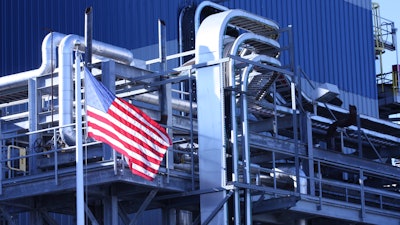
During my college days in the early 1960s, I took a sociology course that featured a sociological study of Middletown, U.S.A. Middletown turned out to be Muncie, Indiana, which at the time was enjoying the rewards of well-paid manufacturing jobs and good living standards. It appeared to be an ideal city with a good future, but that began to change in the 1970s when companies like Borg Warner and Ball Glass began laying off workers, and America accepted deindustrialization as the inevitable consequence of free-market capitalism.
Muncie lost 10,000 factory jobs beginning in 1970, and the population declined from a high of 134,000 in 1972 to 115,000 in 2016. Most departing companies tore down their factories, but remnants remain like the vacant lot of the Borg Warner factory. Muncie, IN is only one example of cities that were victims of outsourcing and NAFTA. Here are a few more:
- Newton, IA: After Whirlpool bought Maytag, they shut the Newton appliance manufacturing plant down in 2007, and the city lost 1,900 jobs. Much of the production went to Mexico.
- Galesburg, IL: In 2004, Maytag shut down its refrigerator plant in Galesburg and moved the production to Reynosa, Mexico. Approximately 2,000 workers lost their jobs.
- Danville, VA: In 1993, Dan River Mills had 6,500 employees operating seven mills. But, after Congress approved NAFTA in 1995, Dan River began laying off their employees, and by 2001, they were all gone. In fact, since the late 1990s, more than 200,000 textile manufacturing jobs in the U.S. have been lost, and 650 U.S. textile plants were closed.
- Dayton, OH: Since 1980, Dayton has lost 15,000 jobs at large companies like NCR, Mead Paper, Delphi, Reynolds and Reynolds and General Motors.
- Bruceton, TN: Bruceton was home to the Henry L. Siegel company (HIS), which manufactured jeans and suits in three large textile plants employing 1,700 workers. After NAFTA, HIS went into free fall, and the last 55 employees were laid off in 2000.
- Youngstown, OH and the Mahoning Valley: This area has been the poster child for deindustrialization and an example of the social costs of deindustrialization. Since the 1980s, the area has lost 40,000 jobs in steel and steel-related industries.
The Ripple Effect
The sudden loss of manufacturing jobs creates an economic ripple effect, where people move away, and the tax base is reduced, which in turn leads to:
- Cuts in public services like police and fire protection
- The closing of small retail shops, grocery stores and the boarding up of businesses
- The foreclosure and abandonment of homes and falling home prices
- Reduced new home construction
- Vacant factory buildings and vacant lots
The ripple effect is called the" broken window syndrome," where decay begets decay and leads to an increase in:
- Crime
- Family violence, suicide, drug and alcohol abuse
- Loss of faith in institutions such as government, business, unions, and churches
- The looting of abandoned homes for items worth selling
- Personal and credit card debt
- A higher share of low-income households
- Poverty assistance from the state and federal government
- Depression and hopelessness
The Economic Justification
Economists have claimed for decades that the decline of manufacturing is a natural transition from a manufacturing to a service economy where "disinvestment allows for the mutation of assets and individuals from older industries to more productive and efficient uses." This concept suggests that deindustrialization frees capital for more efficient use in new industries and ultimately creates new jobs for displaced workers.
The rationalization from economists tries to put a happy face on an economic disaster that has created economic deserts within our borders.
Contrary to economic predictions, the transition has not generated good jobs for people who lost manufacturing jobs. Most were forced to take lower pay and lower-hour service jobs.
In his book, "The Disposable American," Louis Uchitelle argues that when displaced workers find new jobs within two years of being laid off, they still earn only about 40 percent of their previous income.
The China Shock
Job loss is not just in the Midwest. A new analysis by the Coalition for a Prosperous America shows that outsourcing to China has cost 3.4 million American manufacturing jobs since 2001 in 927 cities.
A paper, "On the Persistence of the China Shock," by David Autor, David Dorn and Gordon H. Hanson, says that of 722 U.S. regions analyzed, 223, or 32.8 percent, suffered absolute declines in real per capita income. They say, "The open door for Chinese imports reduced the incomes of one-third of the U.S. public." They continue, "Trade with China is effectively a vehicle to transfer income from working class in the heartland to the affluent."
In the 2021 report, "Gone For Good: Deindustrialization, White Voter Backlash, and U.S. Presidential Voting," by Leonardo Baccini and Stephen Weymouth, the authors argue that deindustrialization threatens dominant group status, leading some white voters in affected localities to favor candidates they believe will address economic distress and defend racial hierarchy. The report shows that "whites associated manufacturing job losses with the loss of upward mobility and with a broader American decline."
I think that this problem is predominantly an economic problem facing white high school-educated Americans who have been left behind in the new service economy. Many working Americans believe upward mobility is no longer valid and the deck is stacked against the average citizen.
According to Amy Taub and Heather McGhee, millions of Americans have a new feeling "that no amount of individual effort or self-improvement or thrift can guarantee a secure middle-class life. The American social contract - a promise of opportunity and security for those who act responsibly - is fundamentally broken."
A large percentage of the working population is struggling economically, and the gap between rich and poor continues to widen, fueling inequality.
Princeton economists Angus Deaton and Anne Case wrote that the life expectancy of Americans without a college degree has been declining since 2010. They attributed the decline to "excessive health care costs, globalization and automation."
Unlike many European countries, the U.S. does not have the social programs to help these communities, and ignoring the people who are facing new economic problems has led to the rise of populism, general unrest and a divided country. We now face long-term changes in the economy where millions will struggle.
Conclusion
If free trade is good for the nation, as economists propose, why haven't the benefits reached all these towns and cities? The answer is that these workers and cities were sacrificed so that consumers could enjoy cheap imported goods.
After 40 years of outsourcing to low-cost countries, America has lost 7.5 million manufacturing jobs and many supply chains, closed 80,000 manufacturing establishments, and destroyed many American towns and communities.
Outsourcing has bled America dry and helped our trading competitors grow.
Free trade became a one-sided process where the benefits flowed to capital and labor costs. It is socialism for capital and free market for labor. For many working Americans, it has become a race to the bottom. So, the big question is: Why should middle-class workers be asked to do all of the sacrificing while the multinationals and their shareholders gain all the spoils?
Put differently, the deindustrialization of America is the direct result of decisions made by corporate and government leaders to pursue economic profit rather than the good of either communities or the country. Congress voted for NAFTA and to gave China "most favored nation" status, and the government did nothing to reduce the flow of Chinese imports — until Trump's Tariffs in 2017. Because communities in economic distress have to turn to state and federal governments for assistance, the social costs of deindustrialization are spread to all citizens in the nation.
America's multinationals are most responsible for what has happened to the employees, communities, manufacturing, suppliers and a good part of the middle class.
On August 19, 2018, 181 U.S. CEOs signed a commitment letter to lead their companies not just for the benefit of their investors but "for the benefit of all stakeholders." If they are serious about this commitment, they could stop outsourcing to China and re-shore production back to the cities they helped destroy.
It is time to face the fact that America turned its back on these communities and workers in support of free trade and shareholder value.





















